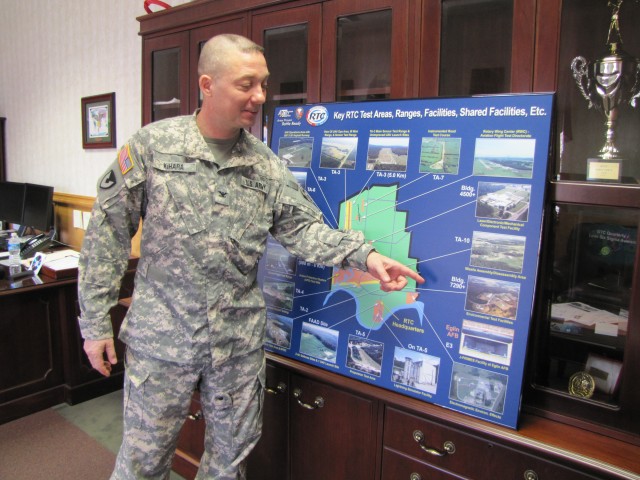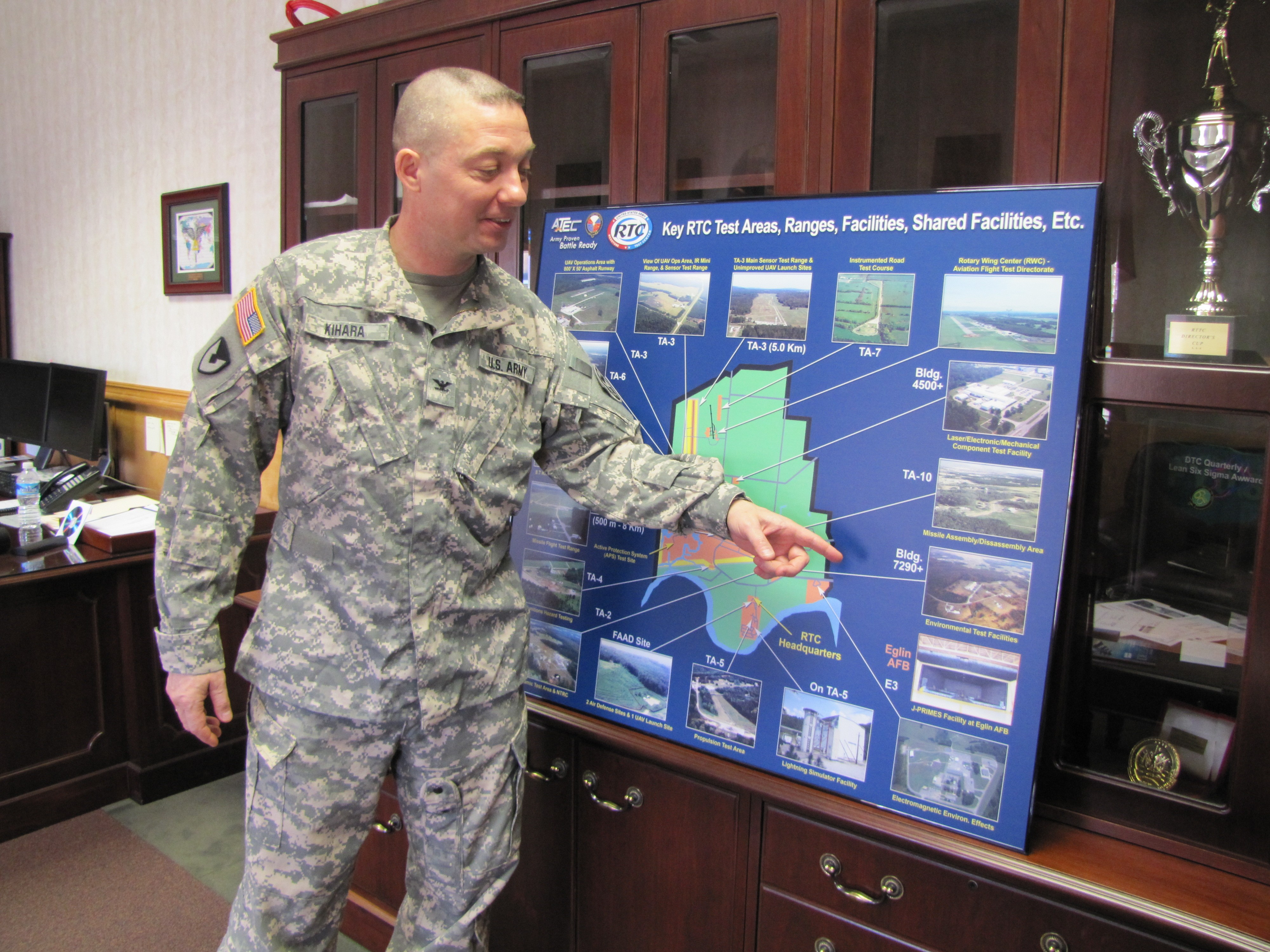
REDSTONE ARSENAL, Ala. -- The footprint of the Redstone Test Center reaches far beyond Redstone Arsenal's gates.
This growing and evolving organization, formed last August with the merger of the Redstone Technical Test Center and the Aviation Technical Test Center at Fort Rucker, is spreading its wings throughout North Alabama, taking advantage of facilities and capabilities provided by the area's small airfields.
And that trend is expected to continue as more of the Army's aviation test operations move to Redstone Arsenal.
"We now have about 80 percent of our aviation testing here at the Redstone Airfield," RTC commander Col. Steve Kihara said. "But we aren't able to do a lot at the airfield because we don't have a hangar."
RTC is using hangars at the Huntsville International Airport and Decatur Pryor Field, and also using facilities and services at outlying airfields in places like Lawrence County and Fayetteville, Tenn.
"Those local communities have opened their arms to us," Kihara said. "They are an infrastructure piece that is very important to our operations. And they will continue to be important to us even after we get our hangar built at the Redstone Airfield."
Since taking over nearly nine months ago as the first Soldier in command of the formerly civilian-controlled Redstone test activities, Kihara has concentrated efforts on making the merger of two respected and accomplished test centers successful. RTC will remain a provisional organization until its one-year anniversary, allowing the new organization 12 months to get its structure and processes in place.
"We've stood up an integrated staff. We have 1,200 folk with about 100 still at Fort Rucker," Kihara said. "We are moving as fast as we can based on BRAC dollars. We are focused right now on establishing systems and processes that make things work. We've stood up an organization that looks like an aviation brigade. We've brought the pieces together to be more efficient and to ensure continuity."
The RTC's new "aviation brigade" is a unique combination of Soldier, civilian and contractor researchers, scientists, technicians and pilots who are working together to test leading-edge aviation, missile and sensor technologies at several test areas on post, the Redstone Airfield and various airfields throughout North Alabama.
"How do we bolt together the aviation culture, and the missile and sensor culture' We do it in a very, very collaborative environment," Kihara said. "What we are doing here is making sure this new organization stays relevant and connected to the war fight."
Merging the two organizations has been challenging, involving a close look at how to bring together each organization's roles and missions, processes and resources. But it has also been invigorating for a colonel who delayed retirement so that he could have a hand in forming a new Army organization.
"It's a huge challenge and, quite frankly, most people don't want to deal with it. It's the mechanical side of making BRAC a reality and it involves lots of details and organizational structure," Kihara said. "We are dealing with issues, and standing up policies and processes that will be in place for many, many years to come. If you do it correctly, you make a huge impact for a long, long time. The processes that are put in place, good or bad, carry on for a long time."
This isn't Kihara's first opportunity to stand up a new organization. In 1995, he was involved in the move of the Aviation Technical Test Center from Edwards Air Force Base, Calif., to Fort Rucker. He learned during that transition about the importance of employing competent civilians to achieve Army goals, and about keeping those employees informed.
"I want to put the smartest people I can between me and the problem," said Kihara, who conducts quarterly town hall meetings with RTC employees. "We all have blind spots. But if you have the employees with the right intelligence, skill set and motivation in place, then you can overcome any problems that your organization faces.
"I also believe we respond to the same things - the organization's vision, processes and recognitions. It's all about putting a phenomenal team in place and then letting them do things that are absolutely amazing and exciting. We're all in this game together."
Kihara said RTC merges together the expertise of two organizations in a way that gains efficiencies and cultivates a scientific synergy that benefits both the aviation side, and the missile and sensor side of the organization.
"Everyone is undergoing a change," he said. "We are all working to adapt to the current environment. Helping me move that change along is David Byrd (formerly the RTTC director and now deputy to Kihara) whose dedication, loyalty and knowledge have been a tremendous asset.
"Maj. Gen. (Jim) Myles (commander of the Aviation and Missile Command and Redstone Arsenal) and his staff have been superb, helpful and supportive. So, too, has the Garrison and the Corps of Engineers, and all of the Redstone and Huntsville communities. In my 26 years of service, this is probably the most welcoming community I've ever been associated with."
Besides standing up RTC, Kihara is also commanding an organization that is undergoing physical growth. The new $20 million RTC hangar at the airfield and headquarters on Martin Road are both under construction. Both are expected to be complete by April 2011.
Kihara is looking forward to seeing RTC stood up in its new facilities. They could very well represent a culmination of a 26-year aviation career that has included several command assignments as well as research, development, test, evaluation and acquisition assignments, including test project officer and experimental test pilot at the Airworthiness Qualification Test Directorate at ATTC, Edwards Air Force Base and then later at Fort Rucker; experimental test pilot/UK exchange officer at Boscombe Down, England; experimental test pilot experimental test pilot for the Rapid Prototyping Division of the Aviation Applied Technology Directorate, Fort Eustis, Va.; executive officer and commander of the Naval Test Pilot School, Patuxent River, Md.; and commander of the Aviation Applied Technology Directorate.
"I have had the best that the Army has to offer," said the 47-year-old Kihara, who has accumulated more than 4,000 flight hours in more than 65 different aircraft.
"I've been a commander, an instructor pilot and a test pilot. I've commanded in Korea and was a test pilot at Edwards, Fort Rucker and England. Everything I've done has been because of dumb luck where I've been the only man standing who met the requirements. I've been very fortunate. It's been a great run. And through it all the two things I've loved the most about the Army are the people and being part of something bigger than me."
Kihara knows that ultimately each of his RTC employees is working in support of the Army's Soldiers.
"We exist because of the Soldier," he said. "Our fingerprints are on the equipment those Soldiers are using. What we do here tomorrow shows up down range in combat. We're dealing with an enemy that is very intelligent and very adaptable. We must be number one Soldier focused and we must work to maintain the technological edge for that Soldier. If what we are doing is not value added down range, than it's not worth it."

Social Sharing